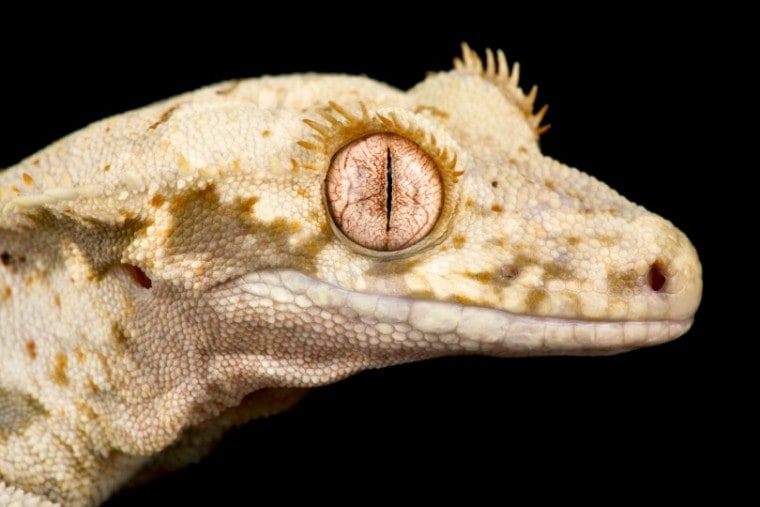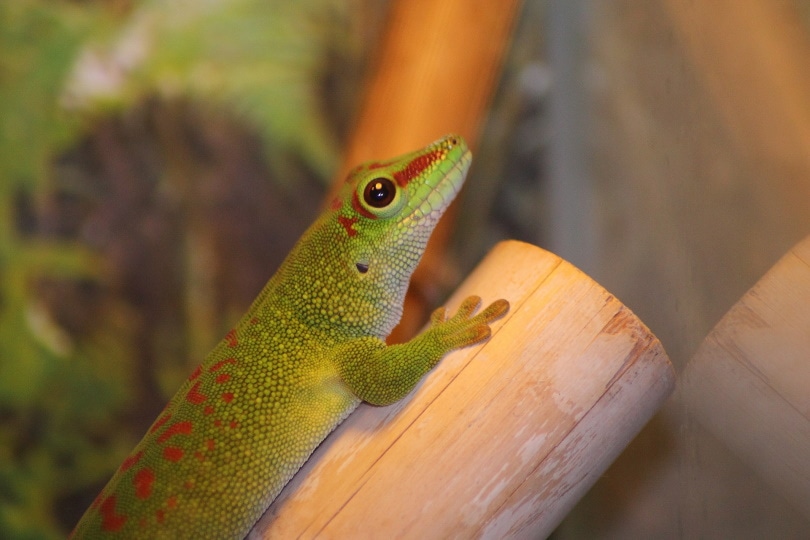
Although quite docile, the crested gecko is well-equipped for agility. It has toe pads that enable vertical movement and they are afforded incredible grip thanks to a prehensile tail that grabs onto branches and other ledges. They are also skilled jumpers. They can make good pets if you want to observe their habits, but crested geckos prefer not to be handled and it can cause them stress.
Part of their popularity is thanks to the range of colors and patterns, but the Lilly white stands out even amid these myriad hues.
Read on to see what equipment your gecko will need and what care you will have to provide.
Quick Facts about Lilly White Geckos

| Species Name: | Correlophus Ciliatus |
| Common Name: | Lilly White Crested Gecko |
| Care Level: | Low |
| Lifespan: | 5 – 10 years |
| Adult Size: | 5 – 8 inches |
| Diet: | Insect, Fruit, Commercial Food |
| Minimum Tank Size: | 10-gallon |
| Temperature & Humidity | 72° – 80° temperature 60% – 80% humidity |
Do Lilly White Crested Geckos Make Good Pets?
The crested gecko is generally docile but does not usually like to be handled. Handling can cause stress and may cause the agile gecko to jump and injure itself.
However, the striking looks and the interesting characteristics of this gecko species make it popular as a hands-off pet. The Lilly White is especially popular, in this case, because it’s even more striking and its lighter colors make it easier to spot in the undergrowth of the terrarium.
Appearance
Also referred to as eyelash geckos, crested geckos have projections above the eyes that look like eyelashes and give the reptile an amiable-looking face.
The Lilly White was first bred by Nick Lumb of Lilly Exotics, which is where the morph gets its name. Lumb noticed a unique coloration from a hatchling born in 2010 and, a couple of years later, bred it with multiple females to discover that the coloration is a co-dominant trait so is passed on to some offspring.
The morph is white or cream-colored with silvery eyes. In most cases, it still has brown markings down the side and the spine of the reptile.
With no eyelids, the crested gecko has a long tongue that it uses to moisten its eyeballs.
How to Take Care of Lilly White Crested Geckos
Habitat, Tank Conditions & Setup
Tank
Crested geckos are semi-arboreal, which means that they will spend some of their time in trees and bushes. An adult requires a tall tank that is, at the very least, 10 gallons in capacity. Ideally, you should make room for a 20-gallon tank to provide enough space. A glass terrarium with vented sides is preferred.
Offer plenty of branches, driftwood, and decorations for climbing and hiding.
Spot clean the tank every day, to remove poop and uneaten insects and food. Provide a full clean every four weeks and ensure all items are thoroughly cleaned before replacing.
Lighting
Because the crested gecko is nocturnal, it does not need UVB light, but keepers have enjoyed success offering a 5% UVB light. Ensure that there is room to hide from the light.
Heating (Temperature & Humidity)
The temperature should vary across the tank, with the cool side at around 72 and the hot side at 80 with temperatures at night dropping around 7. Humidity needs to be monitored and maintained at approximately 60% and a little higher at night. Install a hygrometer to monitor the humidity levels, include a water bowl in the cage, and mist using filtered water throughout the day.
Substrate
Impaction can be a problem for some crested geckos, although certainly not all. This means you should avoid substrates like sand. Opt, instead, for coconut or moss. Wet towels are effective and cheap but do not look as good or last as long.
| Tank Recommendations | |
| Tank Type: | 20-gallon glass vivarium |
| Lighting: | 5% UVB optional |
| Heating: | Heating pad/tape on bottom of enclosure |
| Best Substrate: | Sphagnum moss |
Feeding Your Lilly White Crested Gecko
The crested gecko is an omnivore, which means that it will eat anything. In captivity, this usually means a combination of insects, fruit, some supplementation, and possibly commercial food.
Adults will eat every other day. Feed a commercial food and incorporate live insects. Feed as much as your reptile will eat and remove what is left, and feed roughly this same amount at each sitting to ensure that they are eating a suitable amount of food. Some insects come in different sizes, according to life stage. Ensure that any insect you feed is smaller than the space between the gecko’s eyes.
Gut load insects before feeding and dust with a vitamin D3 powder. You can also feed mashed fruit including bananas, peaches, mangoes, and pears.
| Diet Summary | |
| Fruits: | 25% of diet |
| Insects: | 75% of diet |
| Meat: | 0% of diet |
| Supplements Required: | Vitamin D3/Calcium |
Keeping Your Lilly White Crested Gecko Healthy
As with any pet, the most important element to a healthy and long life is to ensure that they have a good enclosure and a regular, balanced diet. You also need to maintain temperature and humidity, especially to ensure a trouble-free shedding.
Common Health Issues
Your gecko may lead a healthy life, but some of the common health issues associated with this reptile include:
Lifespan
Expect your crested gecko to live a maximum of ten years, with most living 5 years or more.
Breeding
Crested geckos are considered prolific breeders and do not require too much extra effort or equipment. In fact, although a slight drop in temperature may encourage breeding, it isn’t necessary. Keeping a male and female together is usually all that is required to breed this lizard.
Males become sexually mature at around 9 months and around 12 months for a female. A clutch will usually consist of two eggs and a healthy female can lay as often as every month. Provide a nest box with a 4” layer of substrate and ensure that it’s moist.
Eggs will usually hatch between 60 and 90 days after being laid, but this can be longer in winter.
Are Lilly White Crested Geckos Friendly? Our Handling Advice
Many crested geckos do not like being handled and it can cause stress. If yours dislikes handling, avoid it where possible. Otherwise, start small, with minimal contact, and handle for five minutes a day, every other day, ideally during the day when they are less alert. Ensure that you do not handle them at height because if your gecko gets scared, they will try to jump to safety without knowing whether it is safe.
Shedding & Brumation: What to Expect
Like all lizards, the crested gecko sheds regularly as its skin grows. Because they grow quicker, young lizards shed more often than mature. Expect an adult to shed every month or so. Avoid handling and be prepared for your gecko to eat less or stop eating completely while shedding.
How Much Do Lilly White Crested Geckos Cost?
There are various Lilly White morphs available, ranging from dalmatian to phantom, and while all of the variants are popular, their costs do vary. Expect to pay from $500 to $1,000 for one of this popular and sought-after crested gecko morph.
Care Guide Summary
 Final Thoughts
Final Thoughts
The Lilly White crested gecko is a pale white or cream-colored morph of the crested gecko reptile. Although it is not keen on being handled, its good looks and easy maintenance make it a good choice of pet for those that want an attractive reptile. They are considered prolific breeders that do not require much intervention and will live approximately ten years when well cared for.
Featured Image Credit: reptiles4all, Shutterstock







